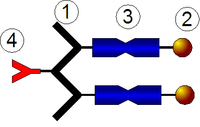
Serum albumin and nucleic acids biodistribution: From molecular aspects to biotechnological applications
Sign Up to like & getrecommendations! Published in 2022 at "IUBMB Life"
DOI: 10.1002/iub.2653
Abstract: Serum albumin (SA) is the most abundant protein in plasma and represents the main carrier of endogenous and exogenous compounds. Several evidence supports the notion that SA binds single and double‐stranded deoxynucleotides and ribonucleotides at… read more here.
Keywords: serum albumin; biodistribution molecular; biotechnological applications; acids biodistribution ... See more keywords

Schizosaccharomyces pombe Biotechnological Applications in Winemaking.
Sign Up to like & getrecommendations! Published in 2018 at "Methods in molecular biology"
DOI: 10.1007/978-1-4939-7546-4_19
Abstract: The traditional way of producing wine is through the use of Saccharomyces cerevisiae in order to convert glucose and fructose into alcohol. In the case of red wines, after this alcoholic fermentation lactic bacteria Oenococus… read more here.
Keywords: pombe biotechnological; biotechnological applications; lactic bacteria; schizosaccharomyces pombe ... See more keywords

d-Aspartate oxidase: distribution, functions, properties, and biotechnological applications
Sign Up to like & getrecommendations! Published in 2020 at "Applied Microbiology and Biotechnology"
DOI: 10.1007/s00253-020-10439-9
Abstract: Recently, substantial levels of acidic d-amino acids, such as d-aspartate and d-glutamate, have been identified in many organisms, from bacteria to mammals, suggesting that acidic d-amino acids have multiple physiological significances. Although acidic d-amino acids… read more here.
Keywords: biotechnological applications; amino acids; ddo; aspartate oxidase ... See more keywords

Therapeutic and biotechnological applications of substrate specific microbial aminopeptidases
Sign Up to like & getrecommendations! Published in 2020 at "Applied Microbiology and Biotechnology"
DOI: 10.1007/s00253-020-10641-9
Abstract: Aminopeptidases (EC 3.4.11.) belongs to exoprotease family, which can catalyze the cleavage of peptide bond which connects the N-terminal amino acid to the penultimate residue in a protein. Aminopeptidases catalyze the process of removal of… read more here.
Keywords: amino; amino acid; biotechnological applications; terminal amino ... See more keywords

Current and potential biotechnological applications of odorant-binding proteins.
Sign Up to like & getrecommendations! Published in 2020 at "Applied microbiology and biotechnology"
DOI: 10.1007/s00253-020-10860-0
Abstract: Odorant-binding proteins (OBPs) are small soluble proteins whose biological function is believed to be facilitating olfaction by assisting the transport of volatile chemicals in both vertebrate and insect sensory organs, where they are secreted. Their… read more here.
Keywords: biotechnological applications; binding proteins; applications odorant; potential biotechnological ... See more keywords

Microbial methionine transporters and biotechnological applications
Sign Up to like & getrecommendations! Published in 2021 at "Applied Microbiology and Biotechnology"
DOI: 10.1007/s00253-021-11307-w
Abstract: Abstract Methionine (Met) is an essential amino acid with commercial value in animal feed, human nutrition, and as a chemical precursor. Microbial production of Met has seen intensive investigation towards a more sustainable alternative to… read more here.
Keywords: biotechnological applications; production; met transporters; biology ... See more keywords

Complete Genome Sequence of Geobacillus thermodenitrificans T12, A Potential Host for Biotechnological Applications
Sign Up to like & getrecommendations! Published in 2017 at "Current Microbiology"
DOI: 10.1007/s00284-017-1349-0
Abstract: In attempt to obtain a thermophilic host for the conversion of lignocellulose derived substrates into lactic acid, Geobacillus thermodenitrificans T12 was isolated from a compost heap. It was selected from over 500 isolates as a… read more here.
Keywords: geobacillus thermodenitrificans; biotechnological applications; thermodenitrificans t12; potential host ... See more keywords

Epigenetic manipulation of filamentous fungi for biotechnological applications: a systematic review
Sign Up to like & getrecommendations! Published in 2020 at "Biotechnology Letters"
DOI: 10.1007/s10529-020-02871-8
Abstract: The study of the epigenetic regulation of gene function has reached pivotal importance in life sciences in the last decades. The mechanisms and effects of processes such as DNA methylation, histone posttranslational modifications and non-coding… read more here.
Keywords: biotechnological applications; filamentous fungi; epigenetic manipulation; manipulation filamentous ... See more keywords

Biotechnological applications of lichen phycobionts: fast bioassay of environmental toxicity
Sign Up to like & getrecommendations! Published in 2020 at "Symbiosis"
DOI: 10.1007/s13199-020-00726-4
Abstract: Microbioassays allow for efficient contamination monitoring and control strategies. Free-living microalgae, representative of the aquatic environment, are the most used organisms due to high sensitivity and reproducibility. However, a lack of testing methods representative of… read more here.
Keywords: phycobionts fast; biotechnological applications; applications lichen; free radical ... See more keywords

Polyhydroxyalkanoates: Trends and advances toward biotechnological applications.
Sign Up to like & getrecommendations! Published in 2021 at "Bioresource technology"
DOI: 10.1016/j.biortech.2021.124737
Abstract: Plastics are an integral part of most of the daily requirements. Indiscriminate usage and disposal have led to the accumulation of massive quantities of waste. Their non-biodegradable nature makes it increasingly difficult to manage and… read more here.
Keywords: biotechnological applications; production; polyhydroxyalkanoates trends; trends advances ... See more keywords

Phycobiliproteins from cyanobacteria: Chemistry and biotechnological applications.
Sign Up to like & getrecommendations! Published in 2019 at "Biotechnology advances"
DOI: 10.1016/j.biotechadv.2019.02.010
Abstract: Phycobiliproteins are a group of water soluble proteins with an associated chromophore, responsible for the light-harvesting in cyanobacteria. They are divided in four main types: phycoerythrin, phycocyanin, phycoerythrocyanin and allophycocyanin, and they are characterized according… read more here.
Keywords: cyanobacteria chemistry; biotechnological applications; phycobiliproteins cyanobacteria; chemistry ... See more keywords